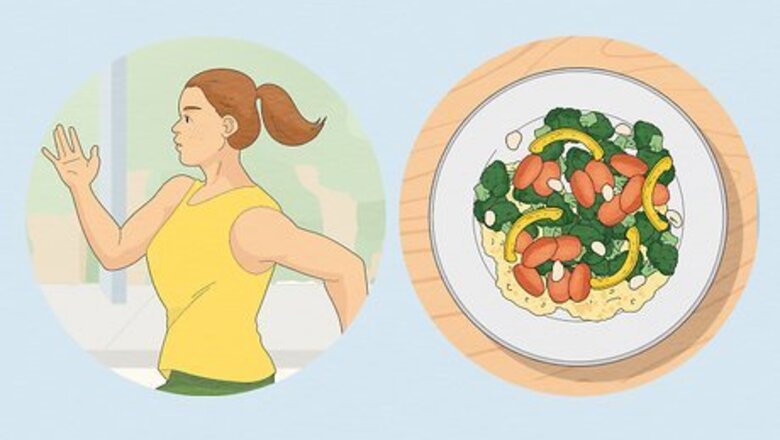
views
- Practice target resistance training workouts a few times a week, such as planking, push-ups, and side crunches.
- Eat a balanced diet of leafy greens, protein-rich lean meats and meat substitutes, and whole grains. To lose fat, try to reduce your calorie intake and stay hydrated.
- Remember that back rolls aren’t inherently unhealthy and may be hard to lose if they’re caused by genetics or age.
How do you reduce back rolls?
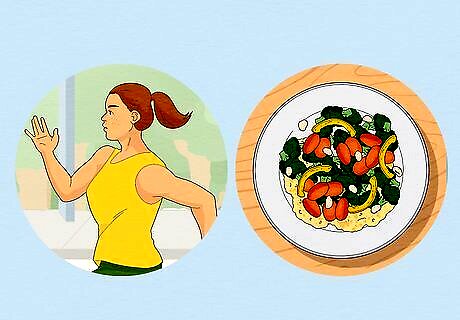
Burn back fat by exercising and adhering to a healthy diet. Back rolls aren't inherently unhealthy, and may be caused by factors beyond your control, such as aging, your environment, or genetics. But if you want to eliminate them or reduce their appearance, 2 to 4 days a week of targeted strength training exercises can help, as can eating more fat-burning foods and reducing caloric intake. You cannot spot-treat back rolls specifically, but that's OK! The strength training exercises that will help burn fat on your back will also burn fat elsewhere on your body. Adjust your workout based on your fitness level, but try to do at least 2 to 6 sets of each exercise 2-4 days a week, with 60 to 90 seconds of rest in between a set. The number of reps of each exercise will depend on the exercise and your skill level. Be sure to give yourself at least a day or 2 each week to rest. In between strength training days, get a half hour of moderate cardio activity in, such as walking, jogging, kickboxing, or dancing.
Exercises to Eliminate Back Rolls
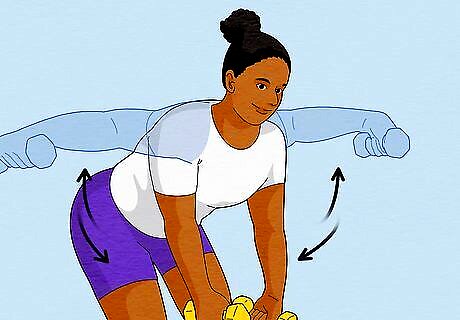
Reverse fly This is a workout that targets your shoulders and arms and will help to strengthen your posterior muscles. You'll need 2 dumbbells to do this dumbbell fly, but any weight will do—choose whatever you’re comfortable with. If you're new to lifting or working with heavier weights, complete 1 to 5 reps; if you're comfortable doing more or using lighter weights, aim for 6 to 12 reps, or more; just go slow to start and listen to your body to know when to stop so you don't injure yourself. Start a rep by standing with your feet shoulder-width apart, holding one dumbbell in each hand at your side. Take a bow, bringing your pelvis back and thrusting your chest forward until your upper body is parallel to the ground. Keep your knees slightly bent—avoid locking them. Let your arms hang by your sides, still holding the dumbbells, with your palms facing one another. Keep your elbows just slightly bent and your chin tucked. Slowly exhale as you raise your arms out to your sides so that they’re parallel with your shoulders—like you’re an airplane. Then slowly lower your arms again while inhaling.
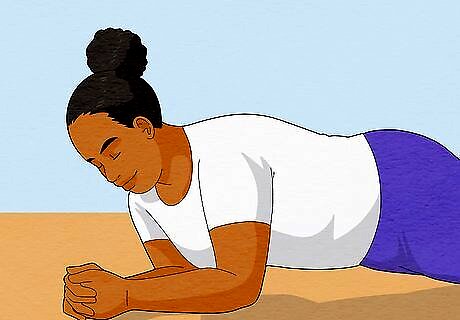
Planks Planking will help strengthen your core as well as strengthen your back muscles. You can use 2 dumbbells for this exercise, but if you don’t have dumbbells or prefer not to use them, you can do without. Assume a push-up position on the floor: hands flat on the ground about shoulder-width apart, arms fully extended, with your body forming a straight line from top to bottom. If you’re using dumbbells, assume the same position, but hold a dumbbell in each hand. Concentrating on holding onto the dumbbells adds an extra challenge to this workout. Hold this position for 5 seconds, then slowly lower yourself to the ground. Do this 6 times. For an added challenge, hold one plank for 30 seconds to 2 minutes (rather than doing 5-second reps). Experts don't recommend planking for longer than 2 minutes as there's not much benefit after that.

Push-ups Push-ups are one of the best workouts to do to burn back fat. They help to stabilize your lumbar and spine by working out your back muscles. Doing push-ups regularly can also reduce back pain and provide you with a leaner physique. Lie down on the ground on your chest with your hands flat at your sides, just outside your shoulders. Keep your feet hip-width apart. For an easier push-up, use a sturdy elevated surface, such as a kitchen counter or a desk, and push off of that. Begin one rep by lifting your hips, thighs, and chest off the floor so that your bodyweight is entirely supported by your toes and your hands. Exhale as you extend your arms until they’re straight. Try to keep your body in a plank position the whole time—totally straight and firm. Inhale as you lower yourself back down again. Aim to complete 10 to 20 reps, but go easy on yourself if you're a beginner.

Side crunches Doing side crunches can help work out your obliques and your abs all at once. You can do this exercise on a Swiss ball, but it’s also totally fine to do it on the floor if you don’t have one or prefer not to use one. Begin one rep by lying on the floor on your side with your legs stacked on top of one another and your knees bent. If you’ve got a Swiss ball, position it a few feet from the wall. Lie on one hip on the ball, positioning each foot against the place where the wall and floor meet, one foot in front of the other. Hold your upper body curled slightly inward at all time and avoid lying with your back pressed against the ball to prevent lower back injury. Place your upper hand behind your head with your elbow bent. Hold your bottom arm out from your body, or use your lower hand to clutch your lower knee or thigh. If you’re on your ball, hold your hands behind your head with your fingers clasped. Crunch your upper side by pulling your upper arm toward your middle, exhaling as you crunch. Try to get your upper arm as close to your upper thigh as you can. On the ball, push your inner elbow towards the wall until your torso is almost upright. Pause and hold this motion for a brief second before inhaling and lowering your side again. Repeat with the other side. Do 10-20 reps.
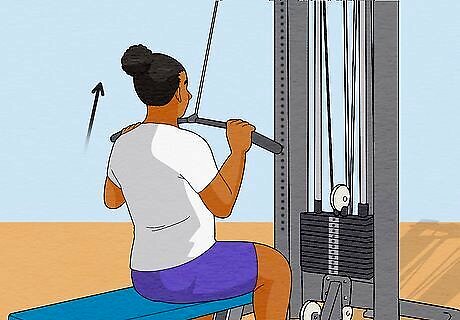
Lat pull-downs Lat pull-downs target your lats, or latissimus dorsi—the muscles located at the middle and lower back that connect your arms to your spine. These muscles help you maintain good posture, stabilize your spine, and support your shoulders and lower back, and exercising them regularly with lat pull-downs can help you burn back fat and eliminate rolls. You can use a pull-down machine for this one, but if you don’t want to make the trek to the gym, use a resistance band and do the workout at home. Start one rep by grasping the middle of the band in both hands with your arms extended upward at a 45-degree angle. Bend your elbows to pull the band down at that same angle, sliding your hands apart along the band as you pull it to your chest. Slowly extend your arms again to return the band to its starting position. Keep control of your movements here; avoid letting the band snap back. Do 15 to 30 reps.
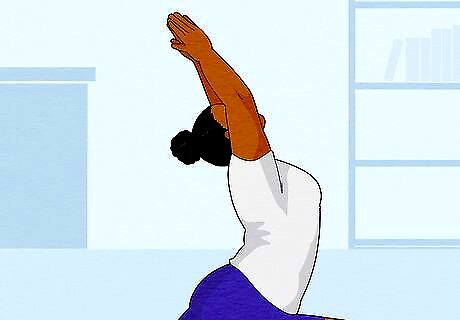
Yoga Yoga is a great exercise for anyone, but it can be especially helpful if you’ve got a sore back that prevents you from doing the other workouts on this list or if you’re out of shape and need a mild workout to help you get back into exercising. Doing yoga can help burn fat on its own, but it also alleviates stress, which can reduce your cortisol levels—that is, the hormone that encourages fat buildup. Try taking a weekly class or doing some light yoga on your own every day to de-stress. Because you can modify yoga to suit your needs, it’s perfect for people who aren’t up for an intense workout. But certain stretches, like the half-moon and warrior 3, can help strengthen and tone your back muscles, reducing back rolls. To do a half-moon pose, stand with your feet flat on your yoga mat and bend over forward so that your upper body is parallel to the ground. Lower your right arm until your hand touches the ground (you may bend your knees slightly if you have to). Lift your left leg behind you so that it is parallel with the ground. Extend your left arm above you, so that it forms a straight line with your other arm. Hold this pose for 10 seconds or so and then repeat with the other side. To do a warrior 3, begin the same way you began the half-moon, standing with your feet flat on the mat and facing forward. Bend your upper body forward so that it's parallel with the ground, but keep your hands akimbo. Lift your right leg until it forms a straight line with your upper body and is parallel to the ground. Hold this pose for 10 seconds and then switch legs.
Eating Well to Eliminate Back Rolls

Stay hydrated. Always make sure you’re drinking plenty of water. Experts recommend drinking about 15.5 cups (3.7 liters) of fluids a day for men and about 11.5 cups (2.7 liters) a day for women. As a general rule, you’re probably well hydrated if you rarely feel thirsty and if your urine is clear or light yellow. Keep in mind that your daily fluid intake doesn’t have to be all plain water: it could also include coffee or tea, or even the water present in certain foods like spinach. Just be sure you’re getting some plain water throughout the day and not relying on low-nutrient beverages like sugary soda for your hydration. Remember to hydrate more when you exercise, especially if you sweat a lot. Try to incorporate more matcha tea into your daily diet: this type of green tea will not only keep you hydrated; its antioxidants can give you more energy and decrease your appetite, which can help you cut back on calories.
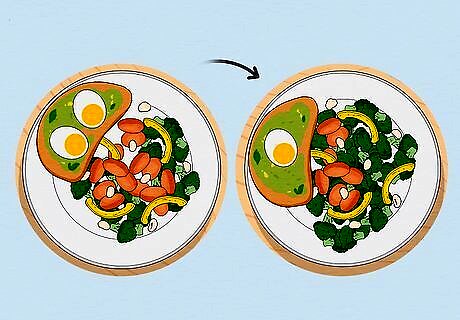
Enter a calorie deficit. Planning your meals and being aware of what and how much you’re consuming will help you enter a calorie deficit—which you need in order to lose back rolls. Eating the right number of calories for your age and body type and being sure you’re getting enough whole foods and green veggies can help you achieve your weight loss goals, but more importantly, it can help you become (and feel) healthier and more energized. How many calories you need to lose weight depends on your body type and age, but generally, you’ll need to cut about 500 calories a day to lose 1 lb (0.45 kg) a week. Avoid letting your caloric intake fall below 1200, for women, or 1500, for men. Try to keep your daily sodium intake under the recommended dose of 2,300 milligrams. While salt is the king of seasoning, it can also lead to bloating and water retention, and it can increase your food cravings. Use a food tracker app like My Fitness Pal or Lifesum to record what you eat each day: it’s a great way to stay aware of what you’re eating. Many apps also let you record your daily physical activity as well. Many people successfully lose weight by calorie counting, but if you struggle with disordered eating or have struggled in the past, calorie counting may be triggering and ultimately not helpful.

Eat high-energy foods. Losing weight isn’t just about cutting back on calories—it’s about being more mindful about what you’re putting into your body each day. Try to get plenty of energizing, nutrient-dense foods every day to ensure your body gets the nourishment it needs to thrive. Eat a balance of leafy greens, whole grains, and protein-rich lean meats or plant-based meat substitutes every day. Even if you are a meat-eater, try to cut back on your red meat intake: studies show eating more plant-based protein, like beans and legumes, can help with weight loss. Fibrous veggies like spinach, sweet potatoes, broccoli, peas, Brussels sprouts, and cauliflower are great sides to any meal: the fiber expands in your stomach, making you feel fuller so you can cut back on your main course portions. Avoid refined flours, artificial sweeteners, and processed meats—these can not only cause chronic inflammation and weight gain, but can lead to other health issues including fatigue and digestive problems. Instead, opt for antioxidant-rich goodies like dark chocolate or berries.
Lifestyle Changes to Reduce Back Rolls
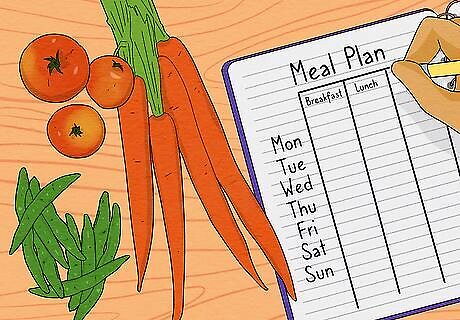
Meal plan. Planning your meals every week is a great way to ensure you know exactly what you’re eating each day. It also takes away some of the stress of trying to figure out what to eat when you’re already hungry and more tempted to give into cravings. Whether you plan whole meals and store them in the fridge or freezer to be eaten throughout the week, or just prep ingredients so they’re ready for cooking when it’s time to eat, planning ahead can help you stay in control of what you’re eating and your portion sizes. If you use a food tracking app, try inputting your meals as you plan them so you have a picture of what your diet for the week will look like ahead of time.
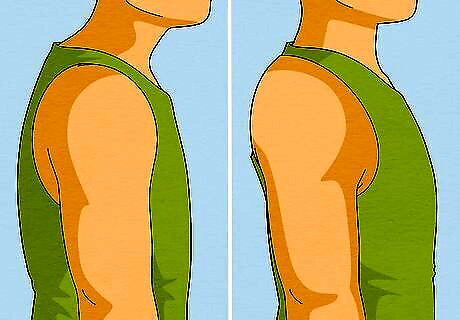
Adopt good posture. Poor posture over time can cause back rolls. Sometimes fat distribution is the cause of back rolls, but if you have poor posture, any soft skin will be more likely to bulge and cause rolls. Your posture may naturally change as you age, making back rolls more likely to occur, but staying aware of your posture may help you eliminate or reduce back rolls. Be mindful of your posture during daily activities, especially sedentary ones, like watching TV or working at a desk job. Regular movement throughout the day can help promote good posture, even if it's just for a few minutes at a time. Yoga in particular can improve flexibility and posture. Ensure work and dining surfaces—like your desk or your kitchen table—are at a comfortable height for you.

Get adequate sleep. Ensure you’re getting between 7-9 hours of quality sleep a night. Lack of sleep can cause your leptin levels to drop; that’s the hormone that manages your appetite, and without it, you’ll be more likely to overeat throughout the day, which can lead to weight gain. Even if you technically get enough sleep, if it’s not quality sleep, it may not really matter. You’ll know you’ve gotten quality sleep if you feel rested the next day, if you don’t wake up during the night, and if you don’t have signs of a sleep disorder, like snoring or gasping for breath.
Surgery to Eliminate Back Rolls
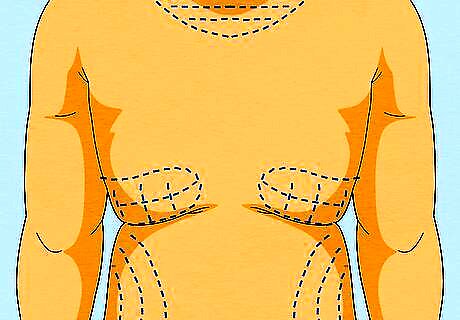
Liposuction can eliminate excess fat from your back. If changing eating habits and exercising doesn’t result in reduced back fat, you may consider the surgical route, but in some instances, excessive weight loss due to exercising and dieting may lead to loose skin that can be surgically removed. Liposuction will remove excess fat from a specific area of the body, such as the back, via suction. If your excess fat is minimal or if you have good skin contractility, liposuction alone may help eliminate or reduce your back rolls. If your back rolls are more pronounced, you may follow the liposuction with a back lift to eliminate the loose skin and sculpt your back to look more natural. A back lift alone will not remove back fat. The average cost for liposuction is $3637, according to the American Society of Plastic Surgeons. This cost involves the surgeon's fees, plus anesthesia, medical tests, hospital costs, and post-surgery garments and medication.
What causes back rolls?
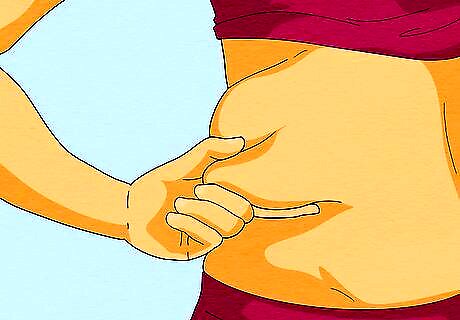
Back rolls can be caused by genetics, posture, lifestyle choices, or aging. Back rolls aren’t necessarily something to be concerned about—excess fat may be caused by factors outside of your control, like genetics, environmental influences, or simply getting older. That said, it’s always worthwhile to eat nourishing foods and get plenty of exercise. Women who enter somatopause (which is when growth hormone levels decline as women age, making it more difficult to maintain muscle) may be more likely to have back rolls.

















Comments
0 comment